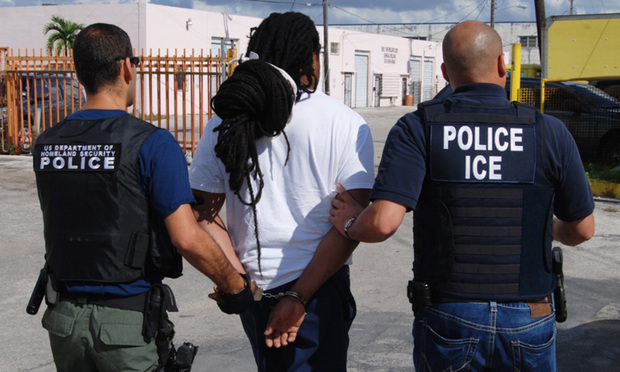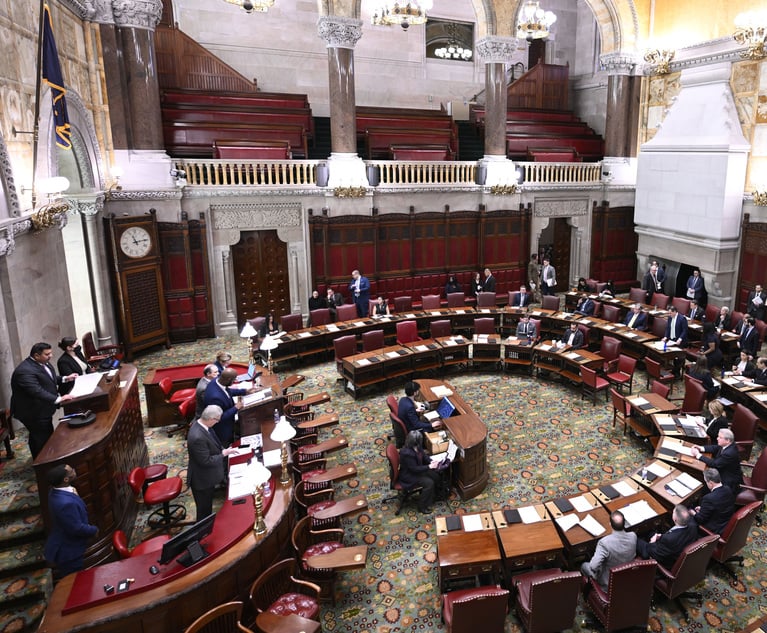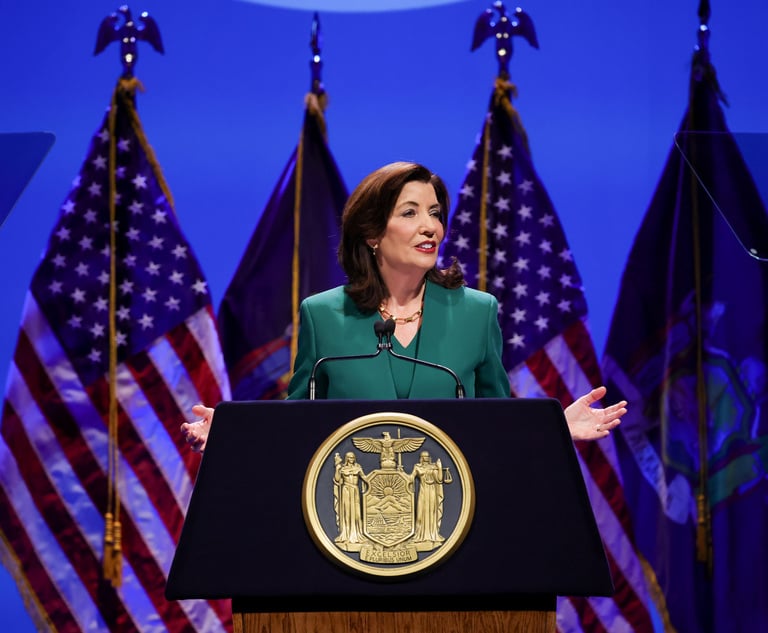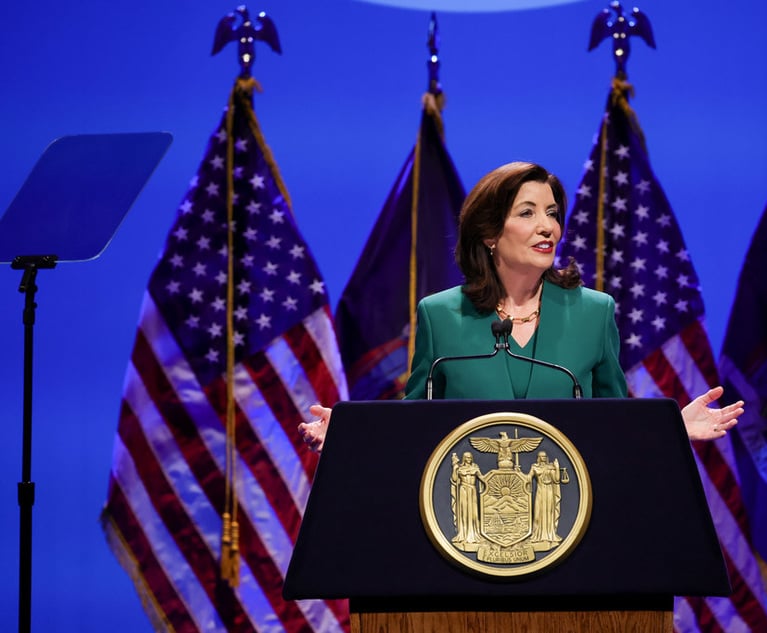Move to Bar ICE Arrests at State Courthouses Gains Momentum Among NY Lawmakers
It's significant that the prevalence of ICE in and around state courthouses remained high last year, compared to previous years, because state court officials had actually instituted new rules intended to prevent those arrests.
January 14, 2020 at 04:18 PM
6 minute read

Legislation that would bar federal immigration authorities from arresting undocumented immigrants in and around state courthouses in New York without a judicial warrant has gained momentum in Albany, with a majority of lawmakers now signed on to sponsor the measure.
The bill, called the Protect Our Courts Act, now has support from more than half of lawmakers in both the state Assembly and Senate, making its chances of passing more likely than ever.
Assemblywoman Michaelle Solages, D-Queens, said Tuesday that she expects the measure to be approved this year after more of her colleagues offered their support. It was first introduced two years ago, but has since failed to gain traction.
"I think this year is the year to do it," Solages said. "We have a lot of momentum and a lot of support. Especially since we now have other legislative initiatives in place, it's now time to take that next step and make sure our courthouses are protected."
The measure now has 80 sponsors in the State Assembly, which is more than half of the 150-member chamber. In the Senate, the measure has 34 sponsors. It only needs 32 votes in the chamber to pass.
Deputy Senate Majority Leader Michael Gianaris, D-Queens, said he's planning to push for the bill to become law this year.
"I will do everything in my power to make this happen," Gianaris said.
The bill is carried in the State Senate by Sen. Brad Hoylman, D-Manhattan. Hoylman, who also chairs the Senate Judiciary Committee, said Tuesday he's also confident lawmakers will approve the measure this year. It's his third year sponsoring the bill.
Hoylman, speaking at a press conference, went after U.S. Immigration and Customs Enforcement, which has ramped up deportation efforts in New York and around the country in recent years. Hoylman said New York's court should be off limits.
"Our courthouses should be sanctuaries for justice, not hunting grounds for ICE to round up members of the immigrant community," Hoylman said.
The comments came the same day that new data was released from the Immigrant Defense Project on the prevalence of civil arrests by federal immigration authorities in and around state courthouses in New York.
The report found that there's been a 1700% increase in the number of incidents involving ICE in and around state courthouses in New York since 2016. The data, obtained from New York state, tracked arrests and sightings each year from 2016 through the end of last year.
The largest spike in ICE courthouse operations was seen in Rockland County, where there was a sevenfold increase over the year before. Nassau, Suffolk and Westchester Counties also experienced an increase in ICE courthouse operations.
It's significant that the prevalence of ICE in and around state courthouses remained high last year, compared to previous years, because state court officials had actually instituted new rules intended to prevent those arrests.
The state Office of Court Administration, last April, administered a directive that required federal immigration authorities to first seek a judicial warrant before attempting to conduct a civil arrest at a state courthouse in New York. Administrative warrants aren't enough.
Mizue Aizeki, deputy director at the Immigrant Defense Project, said the data showed that ICE was not phased by the directive from OCA.
"Despite that directive, ICE did whatever it could to get around it," Aizeki said.
Rather than enter courthouses to make arrests, ICE was found to have targeted immigrants directly outside the building. The directive from OCA does not protect immigrants from civil arrests outside state courthouses.
The report found, as a result, that approximately 80% of total arrests by ICE at state courthouses happened when an immigrant was either on their way into a courthouse, or leaving the building.
The Immigrant Defense Project also claimed that it received reports of sightings where ICE did not make themselves known to court staff, which is also required by the directive.
They also documented instances where immigrants were taken by federal immigration authorities, who showed up in plainclothes and vehicles that weren't marked. At a press conference, lawmakers likened it to a kidnapping.
"We are in the midst of a human rights crisis," Aizeki said. "ICE will go to any means to fulfill their mass deportation agenda."
The Protect Our Courts Act would require ICE agents to identify themselves as federal immigration officers before making a civil arrest. It would also require, like the OCA directive, that ICE officers first receive a judicial warrant before making such an arrest.
But the proposed law would go further than the directive by prohibiting civil arrests by ICE immediately outside courthouses as well. The legislation reads that agents wouldn't be allowed to arrest someone who's either on their way to court, or leaving the building.
"Now with the OCA directive, I think it gives us greater support that we need to codify that in law and create a zone of protection so that ICE agents that are now going across the street won't be able to do that," Solages said.
A spokesman for ICE said Tuesday that federal law allows them to arrest immigrants in courthouses, regardless of what state lawmakers in New York decide to enact.
"ICE officers have been provided broad at-large arrest authority by Congress and may lawfully arrest removable aliens in courthouses, which is often necessitated by local policies that prevent law enforcement from cooperating with ICE efforts to arrange for a safe and orderly transfer of custody in the setting of a state or county prison or jail and put political rhetoric before public safety," the spokesman said.
The legislation is currently pending in the Codes Committee of the State Senate, but could come up for a vote in the Assembly at any time.
READ MORE:
NY Criminal Defense Lawyers Press for Marijuana Legalization, Halt to ICE Courthouse Arrests
Cuomo Signals Support for Bill to Protect Immigrants From ICE Raids at State Courthouses
Immigrants Avoiding State Courts, Legal Services Due to ICE Presence, Report Says
Lawmakers Eye Further Steps to Benefit Immigrants as NY 'Dream Act' Approved
This content has been archived. It is available through our partners, LexisNexis® and Bloomberg Law.
To view this content, please continue to their sites.
Not a Lexis Subscriber?
Subscribe Now
Not a Bloomberg Law Subscriber?
Subscribe Now
NOT FOR REPRINT
© 2025 ALM Global, LLC, All Rights Reserved. Request academic re-use from www.copyright.com. All other uses, submit a request to [email protected]. For more information visit Asset & Logo Licensing.
You Might Like
View All
Relaxing Penalties on Discovery Noncompliance Allows Criminal Cases to Get Decided on Merit
5 minute read
Bipartisan Lawmakers to Hochul Urge Greater Student Loan Forgiveness for Public-Interest Lawyers

'Playing the Clock'?: Hochul Says NY's Discovery Loophole Is to Blame for Wide Dismissal of Criminal Cases

So Who Won? Congestion Pricing Ruling Leaves Both Sides Claiming Victory, Attorneys Seeking Clarification
4 minute readTrending Stories
- 1Whether to Choose State or Federal Court in a Case Involving a Franchise?
- 2Am Law 200 Firms Announce Wave of D.C. Hires in White-Collar, Antitrust, Litigation Practices
- 3K&L Gates Files String of Suits Against Electronics Manufacturer's Competitors, Brightness Misrepresentations
- 4'Better of the Split': District Judge Weighs Circuit Divide in Considering Who Pays Decades-Old Medical Bill
- 5Which Georgia Courts Are Closed Today?—Here's a List
Who Got The Work
J. Brugh Lower of Gibbons has entered an appearance for industrial equipment supplier Devco Corporation in a pending trademark infringement lawsuit. The suit, accusing the defendant of selling knock-off Graco products, was filed Dec. 18 in New Jersey District Court by Rivkin Radler on behalf of Graco Inc. and Graco Minnesota. The case, assigned to U.S. District Judge Zahid N. Quraishi, is 3:24-cv-11294, Graco Inc. et al v. Devco Corporation.
Who Got The Work
Rebecca Maller-Stein and Kent A. Yalowitz of Arnold & Porter Kaye Scholer have entered their appearances for Hanaco Venture Capital and its executives, Lior Prosor and David Frankel, in a pending securities lawsuit. The action, filed on Dec. 24 in New York Southern District Court by Zell, Aron & Co. on behalf of Goldeneye Advisors, accuses the defendants of negligently and fraudulently managing the plaintiff's $1 million investment. The case, assigned to U.S. District Judge Vernon S. Broderick, is 1:24-cv-09918, Goldeneye Advisors, LLC v. Hanaco Venture Capital, Ltd. et al.
Who Got The Work
Attorneys from A&O Shearman has stepped in as defense counsel for Toronto-Dominion Bank and other defendants in a pending securities class action. The suit, filed Dec. 11 in New York Southern District Court by Bleichmar Fonti & Auld, accuses the defendants of concealing the bank's 'pervasive' deficiencies in regards to its compliance with the Bank Secrecy Act and the quality of its anti-money laundering controls. The case, assigned to U.S. District Judge Arun Subramanian, is 1:24-cv-09445, Gonzalez v. The Toronto-Dominion Bank et al.
Who Got The Work
Crown Castle International, a Pennsylvania company providing shared communications infrastructure, has turned to Luke D. Wolf of Gordon Rees Scully Mansukhani to fend off a pending breach-of-contract lawsuit. The court action, filed Nov. 25 in Michigan Eastern District Court by Hooper Hathaway PC on behalf of The Town Residences LLC, accuses Crown Castle of failing to transfer approximately $30,000 in utility payments from T-Mobile in breach of a roof-top lease and assignment agreement. The case, assigned to U.S. District Judge Susan K. Declercq, is 2:24-cv-13131, The Town Residences LLC v. T-Mobile US, Inc. et al.
Who Got The Work
Wilfred P. Coronato and Daniel M. Schwartz of McCarter & English have stepped in as defense counsel to Electrolux Home Products Inc. in a pending product liability lawsuit. The court action, filed Nov. 26 in New York Eastern District Court by Poulos Lopiccolo PC and Nagel Rice LLP on behalf of David Stern, alleges that the defendant's refrigerators’ drawers and shelving repeatedly break and fall apart within months after purchase. The case, assigned to U.S. District Judge Joan M. Azrack, is 2:24-cv-08204, Stern v. Electrolux Home Products, Inc.
Featured Firms
Law Offices of Gary Martin Hays & Associates, P.C.
(470) 294-1674
Law Offices of Mark E. Salomone
(857) 444-6468
Smith & Hassler
(713) 739-1250






